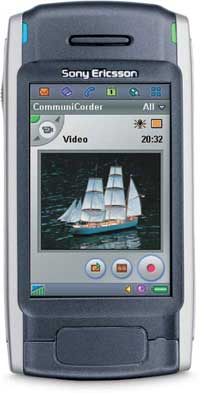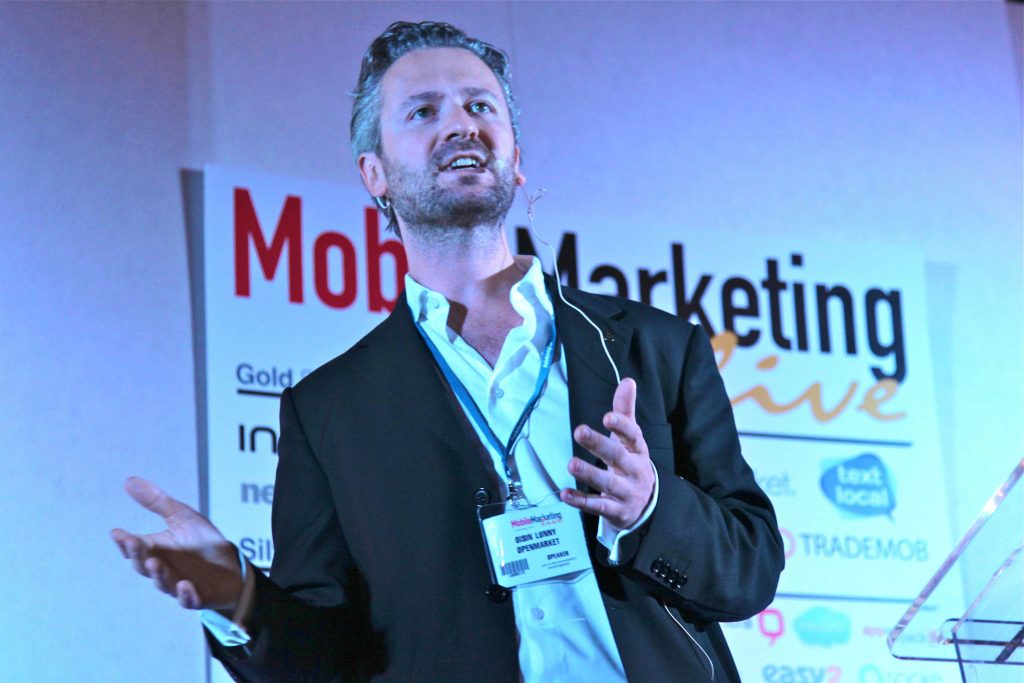Oisin Lunny has been in the world of mobile since the late 90s, or as he says, “the Napster days”. Today Oisin is part of the Market Development team at OpenMarket, providing mobile engagement solutions for global Fortune 2000 companies. He’s worked in technology and media for over 20 years, has spoken at over 130 conferences, contributes to The Guardian and Digital Doughnut, is the digital music editor of Phoenix, sits on advisory boards for SXSW and The Economist Big Think, and was named the #5 most engaged marketer in the UK by LinkedIn.
We caught up with Oisin to talk about what he’s learned after 20 years in the mobile marketing industry…
Music to mobile
Oisin started out in the music industry but soon became “really excited by the new possibilities of technology, and the idea that you could release your music without going through a record label.”
Inspired by the shift technology was bringing to the industry, Oisin got a job as a junior developer at a web agency “after getting some training via a job in tech support at an Internet service provider.” Oisin describes his time in that job as like “literally being in The IT Crowd, answering the phone at 5AM and asking people if they had tried switching it off and on again. It was a great grounding in the industry” he laughs.
While Oisin’s interest in digital was “really motivated by the idea that the Internet could help artists release their own music”, he soon realised that the possibilities of technology were much more exciting to him.
“This shifted my focus away from being a recording artist and musician to being somebody who worked on the technology side of things. This was around the time that companies like MySpace were at their peak and it was a fast-moving time for whole concept of digital content.”
Oisin joined a company called Video-C which ran a site that aggregated video content from all of the major and independent record labels in the UK. “It was quite a difficult feat at the time” he says. “It was new territory, so a lot of the labels were protective… We would aggregate and put together a music video chart that was then syndicated to high traffic websites and also via the Apple QuickTime application.” This part of Apple’s content distribution strategy was subsequently included in their broader iTunes offering.
Learning from Apple
“It was a real privilege to work with Apple back in the very early days of their music strategy” says Oisin. “Because of our partnership with Apple, we got to work with Glenn Bulycz, the director of QuickTime marketing [currently Marketing at iTunes], and he was always somebody who had his finger on the pulse of future technology. He very kindly recommended us to Ericsson Mobility World in Sweden. Because of the recommendation from Glenn, we started working as a partner with Ericsson, putting together music video charts, not only for web and QuickTime, but also for mobile phones.”

Oisin notes that, at this time, “there weren’t many people who had mobile phones that could watch videos”, with the newest Sony Ericsson models being the P800 and P900.
While network limitations and device standards somewhat limited quality and uptake, Video-C launched the first music video chart for Sunrise, a mobile operator in Switzerland. “We had labels like Echo create mobile videos for Roisin Murphy (among others) who I think was hugely popular on mobile phones in Switzerland.
“My route into mobile came from a passion for music and a passion for technology” Oisin says. “The farsighted and visionary people at Apple, Glenn in particular, showed us what was happening with mobile devices and it became really apparent that this was a huge, huge part of the future and how everyone was going to access content.”
Mobile, the music industry and marketing
“There’s been an inevitable shift in many industries where hugely disruptive innovations have been introduced” says Oisin, “and I think mobile device adoption has been possibly the most disruptive new technology of the last century.
“I think it’s the biggest story in technology because of the speed of its adoption. 22 years ago there was around one percent global penetration of mobile devices. A couple of years ago we reached 75 percent. Now all of the predictions from people like Eric Schmidt [CEO of Google parent company Alphabet] state that by 2020 everyone will be online and most data traffic will be from mobile devices.”
“it’s really important to respect the personal nature of these devices”
Oisin appreciates that “there has been a huge impact on the creative content industries, in particular the music industry. But I think these things go in cycles. If you look at a label like XL / Beggars Group (who released the Adele record), they’re immensely successful in this digital age because they have a common sense about how they develop artists and how they release them. Beggars Group are aware of these technology trends and they are protecting the value of music through their strategy. They’re maintaining high quality music that people have come to expect and so they have great loyalty from consumers. There are certain models that don’t work anymore, certainly in terms of digital music. I think highly manufactured music fails to resonate in a market where authenticity is valued above everything else.”
“Highly personalised timely, infrequent and important messages are absolute gold”
The same is true in marketing says Oisin. “We all have these incredibly personal devices with us 24/7, we check them first thing when we wake up, we go to sleep with them at night. These devices are hugely personal in a way that we’ve never seen before. So it’s really important, if you’re in marketing, or any kind of content distribution, to respect the personal nature of these devices and to not assume that they’re broadcast devices in the same way that televisions are.”
It’s this idea of “personal” mobile devices that will be key for marketers moving forwards says Oisin…
“Highly personalised timely, infrequent and important messages are absolute gold. This is what gives a consumer a feeling of being a VIP and enjoying an excellent service through these great devices. If you get that balance right you can really elevate the relationship between a brand and a consumer. But if you get it wrong, the consumer’s going to block you and they’re going to complain.
“I think the legacy of the spray-and-pray marketing approach that’s been used online and in broadcast media for many years, doesn’t translate to mobile. The popularity of ad blocking software, and even network-level ad blocking software, shows loud and clear that consumers do not want to be interacted with in this way. It’s got to be personal and it’s gotta be smart.”
Just because you can doesn’t mean you should
Mobile has opened up a huge number of channels for marketers to communicate with their audiences but “just because you can, doesn’t mean you should” says Oisin.
Because of the personal nature of mobile devices, you don’t really get a second chance
“With push [notifications] the temptation is to keep people updated about everything that’s happening in the app all the time, because you can and because it’s more or less free to do so” says Oisin. “But I’ve uninstalled so many apps just because they’ve sent too many to push notifications. Because of the personal nature of mobile devices, you don’t really get a second chance. Even if an app is useful, if it sends you tons of push notifications you probably won’t go to the trouble of switching off push notifications for that app, you’ll just delete the app altogether because it’s easier.”
The best mobile marketing improves a customer’s experience says Oisin, and expectations are higher then ever. “The last best interaction that a consumer has had with a brand is what they subsequently expect from every other brand.”
Oisin gives the example of a delivery company who have sent him three messages in the last 24 hours informing him of the whereabouts of his package.
“Three messages in the space 24 hours may seem like a lot, but I’m really grateful to that delivery company because they are improving my experience. I know exactly when the package is arriving so I am able to schedule things for the rest of the day. It’s wonderful.
“Quantity of messages is not a big issue, if they are the right messages at the right time. It’s always a case of quality and how the communications genuinely improve the customer experience. The sad reality is that a lot of people don’t think this through in terms of messaging, and they just assume that because the pipe is open to communicate with the consumer, you need to do it frequently. What you really need to do is stand in the consumer’s shoes.”
Using communication to fix the leaky bucket
At OpenMarket, Oisin and the team look at user journeys to figure out where they can remove pain with good communication. He uses being put on hold as an example. “We can take the painful part, like the flute solo hold music, and replace this with a text message. Instead of ringing up and hearing ‘your call is important to us’ repeated for half an hour, avec flute solo, users can send a text with the word ‘support’ to a mobile shortcode. Then the customer could get a personalised text message back saying ‘thank you for your support request, our operative will call you in six minutes’. That feels like VIP service.”
“On a mobile device” Oisin says, “there are five channels to communicate: email, SMS, push notifications, voice and mobile web. All those channels are valid for different scenarios. It’s important to think about the right message on the right channel at the right time.
“For example, an e-mail is going to be best for things like product guarantees, brochures or large documents. But if it’s a communication that is important and needs to be read without any guesswork, enterprises should send a text message, 98% of SMS messages are read within minutes. If it’s something that’s going to enhance the experience of an app, send a push notification or an SMS.”
The future of mobile
Oisin finds it “interesting to look at the trends in the connected home and with Amazon Alexa and voice activated assistants. There might well be an overlap between mobile devices and how we interface with IOT connected devices. Our smartphones seem to have reached a form factor that is universally loved, whereas the smartwatch, for example, hasn’t really taken off so much because there’s not quite the room to do all the cool stuff that you do on a smartphone.
“Text is a fantastic way of communicating because it’s asynchronous and millennials particularly prefer texting to calling. Calls are seen as intrusive whereas texting is convenient, and the timing of replies are always on the recipient’s terms. I think enterprise to person (E2P) text is going to continue to grow, and will dominate key areas of the communication landscape over the next 10 years.
“After that, it’s anyone’s guess.”
Watch this space for part 2 of our interview with Oisin on the future of mobile marketing. Find out more about Oisin at oisinlunny.com.
Get in touch with Simpleweb today to discuss the future of your business.
If you’d like to discuss your startup or project, get in touch with Simpleweb today.




